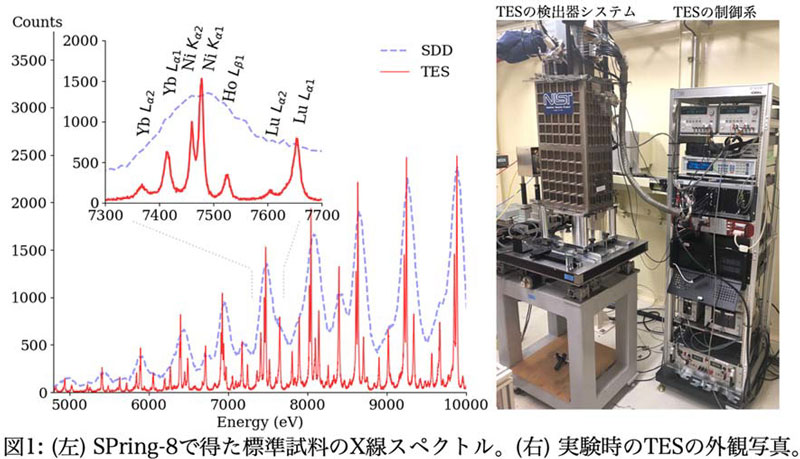Jan 13, 2021PRESS RELEASE
Successful fluorescence XAFS analysis using a superconducting transition-edge sensor (TES) - Paving the way for applications to ultramicroanalysis and emission spectroscopy -
Keyword:RESEARCH
OBJECTIVE.
Researchers including Associate Professor Shinya Yamada and Assistant Professor Yuto Ichinohe of the Rikkyo University College of Science, Tomoya Uruga, Kiyofumi Nitta, and Oki Sekizawa of the Japan Synchrotron Radiation Research Institute (JASRI), and Professor Yoshio Takahashi of the University of Tokyo Graduate School of Science, together with an international team of experts promoting the use of transition-edge sensors (TES)(*1), conducted the world's first successful fluorescence X-ray absorption fine structure (XAFS)(*3) analysis of environmental samples by introducing a TES into the beamline BL37XU at the large synchrotron radiation facility SPring-8(*2). This achievement paves the way for applications in ultramicroanalysis and emission spectroscopy.
The study was published on the website of the U.S. journal "Review of Scientific Instruments" on January 13, 2021 (2 a.m. Japan time). Through the study, it is now possible to use fluorescence XAFS to conduct high-sensitivity state analysis of ultratrace elements in terrestrial, environmental, and extraterrestrial substances or biological samples. Developments are also anticipated in high-precision emission spectroscopy methods such high-energy-resolution fluorescence detected X-ray absorption near edge structure (HERFD-XANES). Research on TES is underway on instrument development and applicability in various fields, such as cosmic X-ray observations and atomic, molecular, and nuclear physics. This represents the first step toward nondestructive analysis of the asteroid materials brought back by Hayabusa2 and extraterrestrial samples obtained in future sample return programs.
Background of the study
Research Results
The study was published on the website of the U.S. journal "Review of Scientific Instruments" on January 13, 2021 (2 a.m. Japan time).
“Broadband high-energy resolution hard x-ray spectroscopy using transition edge sensors at SPring-8”

Figure 1: (Left) X-ray spectra of the standard sample obtained at Spring-8. (Right) Photograph of the outside of the TES during the experiment. S. Yamada et al., Rev. Sci. Instrum. 91 (2020), doi: 10.1063/5.0020642
Future prospects
Notes
The international team of experts pursuing the use of TES included the following 42 scientists.
- College of Science, Rikkyo University: Associate Professor Shinya Yamada, Assistant Professor Yuto Ichinohe
- Graduate School of Science, Tokyo Metropolitan University: Associate Professor Yoshitaka Ishisaki, Adjunct Professor Takaya Ohashi, visiting researcher Hideyuki Tatsuno, graduate student Ryota Hayakawa, graduate student Hirotaka Suda
- Japan Synchrotron Radiation Research Institute (JASRI): full-time researcher Tomoya Uruga, researcher Kiyofumi Nitta, senior researcher Oki Sekizawa
- Graduate School of Science, University of Tokyo: Professor Yoshio Takahashi, Associate Professor Takaaki Itai, researcher Hiroki Suga, researcher Masato Tanaka, graduate student Makoto Nagasawa
- Japan Atomic Energy Agency (JAEA) Advanced Science Research Center: researcher Tadashi Hashimoto
- U.S. National Institute of Standards and Technology (NIST): Douglas Bennett, Ed Denison, William Bertrand Doriese, Malcolm Durkin, Joseph Fowler,
- Galen O’Neil, Kelsey Morgan, Dan Schmidt, Daniel Swetz, Joel Ullom, Leila Vale
- Engineering Science Laboratory, Chubu University: Associate Professor Shinji Okada
- RIKEN: senior researcher Toshiyuki Azuma, research fellow Takuma Okumura, senior researcher Toru Tamagawa, full-time researcher Tadaaki Isobe
- Device Technology Research Institute, National Institute of Advanced Industrial Science and Technology: general research chief Satoshi Kojiro
- Graduate School of Science, Osaka University: Assistant Professor Hirofumi Noda
- Graduate School of Natural Science & Technology, Kanazawa University: graduate student Keigo Tanaka, graduate student Akimichi Taguchi
- Graduate School of Science and Engineering, Saitama University: Associate Professor Kosuke Sato, graduate student Yuki Imai
- JAXA Institute of Space and Astronautical Science (ISAS): researcher Tasuku Hayashi
- Japan Agency for Marine-Earth Science and Technology (JAMSTEC): researcher Teruhiko Kashiwabara, researcher Minako Kurisu
- National Institute for Environmental Studies (NIES): researcher Kohei Sakata
(*2)
A RIKEN facility that produces world-leading high-performance synchrotron radiation that is supported by the Japan Synchrotron Radiation Research Institute (JASRI) and others. Located in Harima Science Park City in Hyogo Prefecture. The name SPring-8 comes from super photon ring-8 giga electron volt (GeV). Synchrotron radiation is the highly directional and powerful electromagnetic waves that are generated when electrons are accelerated to close to the speed of light and their direction of travel is bent by an electromagnet. SPring-8 conducts a wide range of research using synchrotron radiation into fields that include nanotechnology, biotechnology, and industrial uses.
(*3)
Fluorescence X-ray absorption fine structure (XAFS) analyzes the X-ray fluorescence of various wavelengths generated when a substance is irradiated with X-rays, and is used to investigate the elements, types, and chemical states of substances.

Figure 2: Principles of TES operation and TES pixel diagram
TES is a detector that utilizes the steep resistance-temperature characteristics near the phase transition temperature of superconductivity and normal conduction. Figure 2 shows how it operates. When X-rays hit the heat-absorbing part of the detector, the temperature of the TES rises, along with its resistance.
By detecting changes in the current flowing through the circuit, the energy of the irradiated X-rays can be estimated. Because the change in resistance during this is extremely large in superconductors near the phase transition temperature, the energy estimates have good accuracy.
High-energy-resolution fluorescence detected X-ray absorption near edge structure (HERFD-XANES) is a method of fluorescence XAFS for finely separating the wavelengths of specific X-ray fluorescence (spectroscopically with high energy resolution). In the past crystals were used for spectroscopy, but a drawback of this is that much useful information is discarded. Using a non-dispersive spectroscope such as TES could increase the efficiency of measurements.